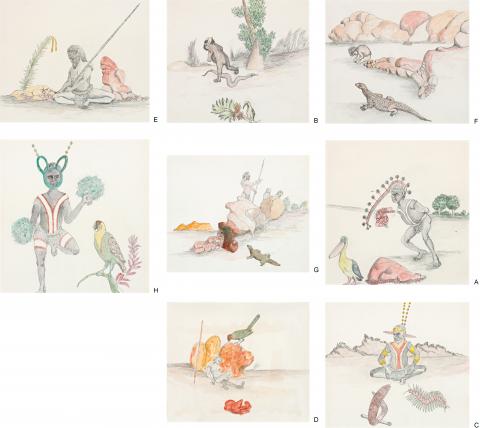A SUITE OF EIGHT DRAWINGS, 1981
BUTCHER JOE NANGAN
pencil and watercolour on paper
(A) MAYATA –THE PELICAN,
22.5 x 22.5 cm
(B) MIRUTU MIRUTU – THE MESSENGER,
22.0 x 25.0 cm
(C) MYIMERE –THE SONG MAN,
22.5 x 26.0 cm
(D) TUURRU,
19.5 x 23.5 cm
(E) MUTJUNAN – MYTHICAL TRAVELLER,
21.0 x 26.0 cm
(F) TARRBAI AND THE GOANNA,
22.0 x 26.0 cm
(G) NGALYAK – THE SKINK,
22.0 x 26.5 cm
(H) PIRRA PIRRA – THE DOG MAN,
24.0 x 23.0 cm
Commissioned by Mary Macha for Aboriginal Traditional Arts, Perth
Private collection, Sydney
Aboriginal Traditional Arts,
Perth Gallery, Perth, 1981
Butcher Joe Nangan was born across the Dampier Creek from Broome and spent his life acquiring the ritual knowledge of the Nyikina people. Known for his skilful engraving of boab nuts and pearl shell, by 1955 Nangan had begun producing beautifully executed pencil and watercolour pictures of flora, fauna and mythological spirit beings in a western naturalistic style. ‘He recorded and transmitted a vast body of cultural knowledge. He was acutely aware of the increasingly rapid loss of historical and other cultural information in the late twentieth century.. He... drew from a range of historical events in which elements of the supernatural and spirit worlds were thought to have entered the lives of known mortals. Rai (spirit beings), guardians of the plants and animals, bearers of the spirits of children, were also a favourite topic. The Aboriginal community believed that Nangan interacted with these little, somewhat mischievous, yet helpful, beings, and that they were the source of spiritual knowledge and power.’1 In the 1970s and 1980s Nangan was commissioned by Mary Macha to produce works for exhibition at Aboriginal and Traditional Arts in Perth. These eight watercolours purchased in 1981 contain a broad variety of imagery, including images of ceremony, mythological narratives, Rai (spirit beings), flora and fauna and depictions of sacred boards, utilitarian weapons and objects.;’
1. Kleinert, S. and Neale, M., The Oxford Companion to Aboriginal Art and Culture, Oxford University Press, Melbourne, 2000, p. 658
